In-Depth Analysis of Shut-In Time Using Post-Fracturing Flowback Fluid Data—Shale of the Longmaxi Formation in the Luzhou Basin and Weiyuan Basin of China as an Example
Abstract
1. Introduction
2. Geological Settings

3. Experimental Section
3.1. Samples
3.2. Methods
- Sample Preparation
- 2.
- NMR Analysis
- 3.
- Beaker Preparation
- 4.
- Conducting Spontaneous Imbibition and Ion Diffusion Experiments
- 5.
- Continuous Testing

3.3. Results and Discussion
4. Determination of Characteristic Length Scale at the Field Scale
4.1. Theoretical Model
4.2. Application of Theoretical Model
5. Case Study for Shut-In Time at Field Scale
- Conduct laboratory-scale spontaneous imbibition tests to determine the shut-in time at the lab scale.
- Use Equation (5), with parameters such as porosity, permeability, surface tension, and lab-scale shut-in time, to calculate the dimensionless time.
- Regularly collect and measure the total salinity, ion types, total volume, and flowback efficiency of the fracturing flowback fluid.
- Calculate the distribution of fracture widths using Equation (10).
- Utilize Equation (2) by substituting the dimensionless time, flowback efficiency, fracture width, and other parameters calculated in steps 2–4 to compute the matrix block length at the field scale.
- Determine the characteristic length at the field scale using Equation (6) and calculate the field-scale shut-in time by substituting it into Equation (5).

6. Conclusions
- (1)
- Post-fracturing shut-in is a primary technique for enhancing ultimate gas recovery in shale gas wells. Spontaneous imbibition plays a crucial role in the microscale flow. Conducting spontaneous imbibition tests helps to gain a deeper understanding of the imbibition of fracturing fluid during field-scale shut-in. The results of spontaneous imbibition tests on cores from deep shale gas wells in Luzhou and medium-deep shale gas wells in Weiyuan indicated that during the initial stage of imbibition, water absorption of the cores showed a positive correlation with the square root of time. The time at which water absorption reached a stable stage represented the lab-scale shut-in time.
- (2)
- The distinctive “liquid–salt” dynamic curve of shale gas wells provides valuable insights for evaluating the morphology of volume fracturing networks. By comparing the variations in salinity and flowback efficiency of the flowback fluid between the deep shale gas wells in Luzhou and the medium-deep shale gas wells in Weiyuan, the characteristics of the fracture width distribution were analyzed. The findings revealed that the flowback fluid from the medium-deep shale gas wells exhibited higher salinity, narrower hydraulic fractures, a larger fracture surface area and volume, denser hydraulic fracture networks, and more complex fracture network morphology.
- (3)
- Determining the field-scale shut-in time based on dimensionless time models is a conventional research approach, but selecting the characteristic length at the field scale remains a challenge. The field-scale shut-in time does not necessarily exhibit a positive correlation with the lab-scale shut-in time. Its outcomes are influenced by factors such as imbibition rate, salinity of the fracturing flowback fluid, and flowback efficiency. It is crucial to continuously monitor the fluid loss behavior and proppant flowback behavior during shut-in to further refine the optimization method for field-scale shut-in time.
Author Contributions
Funding
Data Availability Statement
Acknowledgments
Conflicts of Interest
References
- Li, L.; Wu, F.; Cao, Y.; Cheng, F.; Wang, D.; Li, H.; Yu, Z.; You, J. Sustainable development index of shale gas exploitation in China, the UK, and the US. Environ. Sci. Ecotechnol. 2022, 12, 100202. [Google Scholar] [CrossRef] [PubMed]
- Aruga, K. The U.S. shale gas revolution and its effect on international gas markets. J. Unconv. Oil Gas Resour. 2016, 14, 1–5. [Google Scholar] [CrossRef]
- Soeder, D.J. The successful development of gas and oil resources from shales in North America. J. Pet. Sci. Eng. 2018, 163, 399–420. [Google Scholar] [CrossRef]
- Edwards, R.W.J.; Celia, M.A. Shale Gas Well, Hydraulic Fracturing, and Formation Data to Support Modeling of Gas and Water Flow in Shale Formations. Water Resour. Res. 2018, 54, 3196–3206. [Google Scholar] [CrossRef]
- Dehghanpour, H.; Ezulike, D.O.; Abbasi, M.A.; Hawkes, R.V. A comparative study of flowback rate and pressure transient behavior in multifractured horizontal wells completed in tight gas and oil reservoirs. J. Nat. Gas Sci. Eng. 2014, 17, 82–93. [Google Scholar]
- Yu, H.; Xu, W.; Li, B.; Huang, H.; Micheal, M.; Wang, Q.; Huang, M.; Meng, S.; Liu, H.; Wu, H. Hydraulic Fracturing and Enhanced Recovery in Shale Reservoirs: Theoretical Analysis to Engineering Applications. Energy Fuels 2023, 37, 9956–9997. [Google Scholar] [CrossRef]
- Yang, L.; Liu, Y.; Wang, W.; Li, M.; Wang, S.; Xu, B.; Shi, Y.; Chen, H. Pore-scale flow mechanism of immiscible gas-assisted gravity drainage in strongly heterogeneous glutenite reservoirs. Int. J. Coal Sci. Technol. 2025, 12, 12. [Google Scholar] [CrossRef]
- Meng, M.; Ge, H.; Shen, Y.; Ji, W. Fractal characterization of pore structure and its influence on salt ion diffusion behavior in marine shale reservoirs. Int. J. Hydrogen Energy 2020, 45, 28520–28530. [Google Scholar] [CrossRef]
- Eltahan, E.; Rego, F.; Yu, W.; Sepehrnoori, K. Impact of well shut-in after hydraulic-fracture treatments on productivity and recovery of tight oil reservoirs. J. Pet. Sci. Eng. 2021, 203, 108592. [Google Scholar] [CrossRef]
- Chen, M.; Bai, J.; Kang, Y.; Chen, Z.; You, L.; Li, X.; Liu, J.; Zhang, Y. Redistribution of fracturing fluid in shales and its impact on gas transport capacity. J. Nat. Gas Sci. Eng. 2021, 86, 103747. [Google Scholar] [CrossRef]
- Xu, G.; Jiang, Y.; Shi, Y.; Han, Y.; Wang, M.; Zeng, X. Experimental investigations of fracturing fluid flowback and retention under forced imbibition in fossil hydrogen energy development of tight oil based on nuclear magnetic resonance. Int. J. Hydrogen Energy 2020, 45, 13256–13271. [Google Scholar] [CrossRef]
- Ibrahim, A.F.; Nasr-El-Din, H.A. Effect of well shut-in after fracturing operations on near wellbore permeability. J. Pet. Sci. Eng. 2019, 181, 106213. [Google Scholar] [CrossRef]
- Wijaya, N.; Sheng, J. Effect of desiccation on shut-in benefits in removing water blockage in tight water-wet cores. Fuel 2019, 244, 314–323. [Google Scholar] [CrossRef]
- Li, Q.C.; Wu, J.; Li, Q.; Zhou, X.; Li, Y.; Chi, P.; Han, Y.; Ansari, U.; Cheng, Y. Sediment Instability Caused by Gas Production from Hydrate-Bearing Sediment in Northern South China Sea by Horizontal Wellbore: Sensitivity Analysis. Nat. Resour. Res. 2025, 34, 1595–1620. [Google Scholar]
- Li, Q.; Wang, Y.L.; Wang, Y.J.; San, J.; Li, Q.; Foster, G. Synthetic process on hydroxyl-containing polydimethylsiloxane as a thickener in CO2 fracturing and thickening performance test. Energy Sources Part A Recovery Util. Environ. Eff. 2018, 40, 1137–1143. [Google Scholar] [CrossRef]
- Wang, M.; Leung, J.Y. Numerical investigation of fluid-loss mechanisms during hydraulic fracturing flow-back operations in tight reservoirs. J. Pet. Sci. Eng. 2015, 133, 85–102. [Google Scholar] [CrossRef]
- Habibi, A.; Dehghanpour, H.; Binazadeh, M.; Bryan, D.; Uswak, G. Advances in Understanding Wettability of Tight Oil Formations: A Montney Case Study. SPE Reserv. Evaluation Eng. 2016, 19, 583–603. [Google Scholar] [CrossRef]
- Ghanbari, E.; Dehghanpour, H. The fate of fracturing water: A field and simulation study. Fuel 2016, 163, 282–294. [Google Scholar] [CrossRef]
- Sharma, M.; Agrawal, S. Impact of Liquid Loading in Hydraulic Fractures on Well Productivity. J. Pet. Technol. 2013, 65, 162–165. [Google Scholar]
- Shaibu, R.; Guo, B. The dilemma of soaking a hydraulically fractured horizontal shale well prior to flowback—A decade literature review. J. Nat. Gas Sci. Eng. 2021, 94, 104084. [Google Scholar] [CrossRef]
- Lan, Q.; Dehghanpour, H.; Hawkes, R.; Ghanbari, E. Water Loss Versus Soaking Time: Spontaneous Imbibition in Tight Rocks. Energy Technol. 2014, 2, 1033–1039. [Google Scholar] [CrossRef]
- Roychaudhuri, B.; Tsotsis, T.; Jessen, K. An Experimental Investigation of Spontaneous Imbibition in Gas Shales. J. Pet. Sci. Eng. 2013, 111, 87–97. [Google Scholar] [CrossRef]
- Habibi, A.; Dehghanpour, H.; Kuru, E.; Makhanov, K. Liquid Uptake of Gas Shales: A Workflow to Estimate Water Loss During Shut-in Periods After Fracturing Operations. J. Unconv. Oil Gas Resour. 2014, 7, 22–32. [Google Scholar]
- Zhang, X.; Morrow, N.; Ma, S. Experimental Verification of a Modified Scaling Group for Spontaneous Imbibition. Spe Reserv. Eng. 1996, 11, 280–285. [Google Scholar] [CrossRef]
- Ma, S.; Morrow, N.; Zhang, X. Generalized Scaling of Spontaneous Imbibition Data for Strongly Water-wet Systems. J. Pet. Sci. Eng. 1997, 18, 165–178. [Google Scholar]
- Wu, Y.-S.; Kazemi, H.; Torcuk, M.; Fakcharoenphol, P. Effect of shut-in time on gas flow rate in hydraulic fractured shale reservoirs. J. Nat. Gas Sci. Eng. 2016, 32, 109–121. [Google Scholar]
- Wijaya, N.; Sheng, J. Comparative Study of Well Soaking Timing (Pre. Vs. Post Flowback) for Water Block Removal from Matrix-Fracture Interface. Petroleum 2020, 6, 286–292. [Google Scholar]
- Hu, J.; Zhao, H.; Du, X.; Zhang, Y. An analytical model for shut-in time optimization after hydraulic fracturing in shale oil reservoirs with imbibition experiments. J. Pet. Sci. Eng. 2022, 210, 110055. [Google Scholar] [CrossRef]
- Bertoncello, A.; Honarpour, M.M.; Kabir, C.S.; Wallace, J.; Blyton, C. Imbibition and water blockage in unconventional reservoirs: Well-management implications during flowback and early production. SPE Reserv. Eval. Eng. 2014, 17, 497–506. [Google Scholar] [CrossRef]
- Zolfaghari, A.; Dehghanpour, H.; Bearinger, D. Fracture Characterization using Flowback Salt-Concentration Transient. SPE J. 2016, 21, 233–244. [Google Scholar] [CrossRef]
- Yang, L.; Wang, S.; Cai, J.; Gan, Y.; Salama, A. Main controlling factors of fracturing fluid imbibition in shale fracture network. Capillarity 2018, 1, 1–10. [Google Scholar] [CrossRef][Green Version]
- Huang, H.; He, D.; Li, Y.; Li, J.; Zhang, L. Silurian tectonic–sedimentary setting and basin evolution in the Sichuan area, southwest China: Implications for palaeogeographic reconstructions. Mar. Pet. Geol. 2018, 92, 403–423. [Google Scholar] [CrossRef]
- Ma, X.; Wang, H.; Zhou, S.; Feng, Z.; Liu, H.; Guo, W. Insights into NMR response characteristics of shales and its application in shale gas reservoir evaluation. J. Nat. Gas Sci. Eng. 2020, 84, 103674. [Google Scholar] [CrossRef]
- Ma, X.; Xie, J.; Yong, R.; Zhu, Y.Q. Geological characteristics and high production control factors of shale gas reservoirs in silurian longmaxi formation, southern sichuan basin, SW China. Pet. Explor. Dev. 2020, 47, 901–915. [Google Scholar] [CrossRef]
- Feng, Y.; Xiao, X.; Gao, P.; Wang, E.; Hu, D.; Liu, R.; Li, G.; Lu, C. Restoration of sedimentary environment and geochemical features of deep marine longmaxi shale and its significance for shale gas: A case study of the dingshan area in the sichuan basin, south China. Mar. Pet. Geol. 2023, 151, 106186. [Google Scholar] [CrossRef]
- Yang, L.; Yang, D.; Zhang, M.; Meng, S.; Wang, S.; Su, Y.; Long, X. Application of nano-scratch technology to identify continental shale mineral composition and distribution length of bedding interfacial transition zone—A case study of Cretaceous Qingshankou formation in Gulong Depression, Songliao Basin, NE China. Geoenergy Sci. Eng. 2024, 234, 212674. [Google Scholar] [CrossRef]
- Yang, L.; Yang, D.; Li, Y.; Cai, J.; Jiang, X. Nanoindentation study on microscopic mineral mechanics and bedding characteristics of continental shales. Energy 2024, 312, 133614. [Google Scholar] [CrossRef]
- Jiang, Y.; Shi, Y.; Xu, G.; Jia, C.; Meng, Z.; Yang, X.; Zhu, H.; Ding, B. Experimental Study on Spontaneous Imbibition under Confining Pressure in Tight Sandstone Cores Based on Low-Field Nuclear Magnetic Resonance Measurements. Energy Fuels 2018, 32, 3152–3162. [Google Scholar] [CrossRef]
- Yang, L.; Wang, H.; Xu, H.; Guo, D.; Li, M. Experimental study on characteristics of water imbibition and ion diffusion in shale reservoirs. Geoenergy Sci. Eng. 2023, 229, 212167. [Google Scholar] [CrossRef]
- Yang, L.; Ge, H.; Shi, X.; Shen, Y.; Zhang, K.; Qu, X.; Cheng, Y.; Chen, H.; Yang, L. The effect of microstructure and rock mineralogy on water imbibition characteristics in tight reservoirs. J. Nat. Gas Sci. Eng. 2016, 34, 1461–1471. [Google Scholar] [CrossRef]
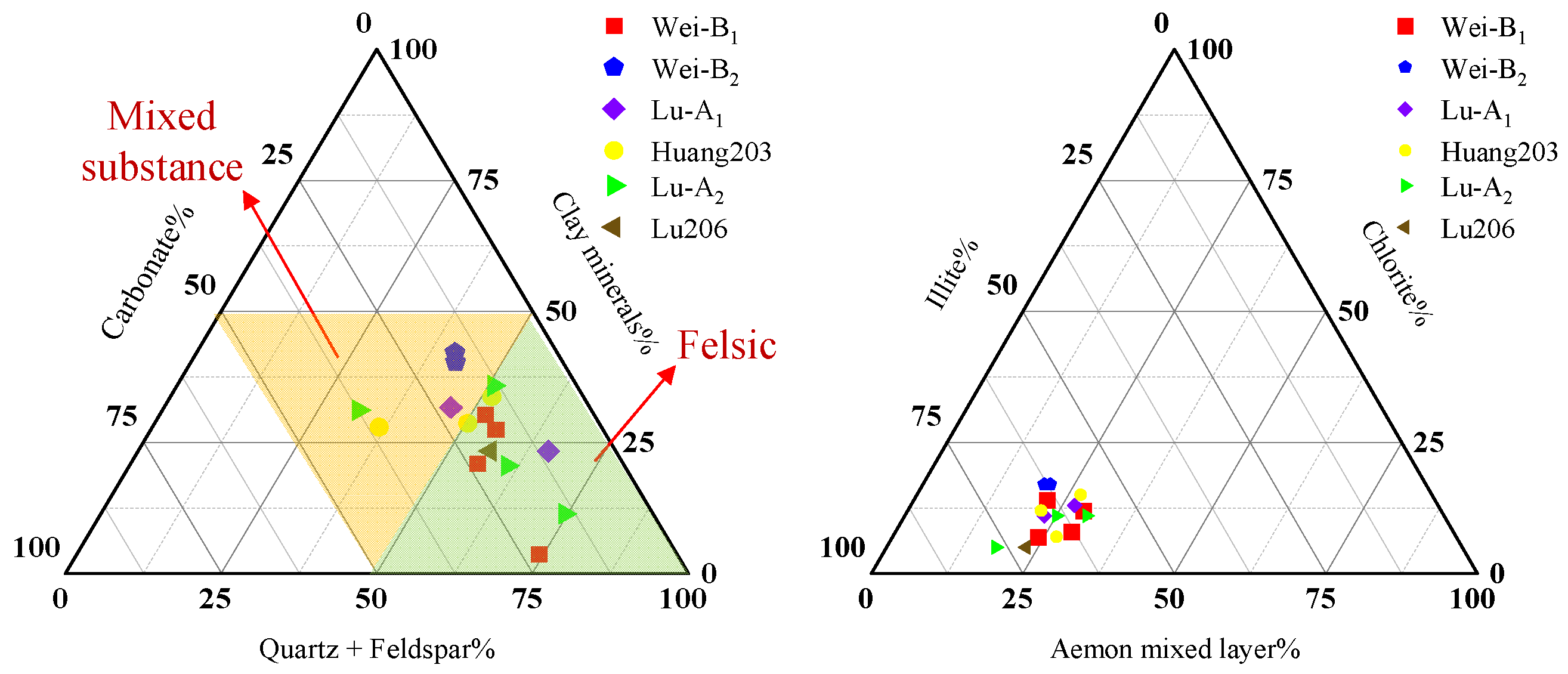


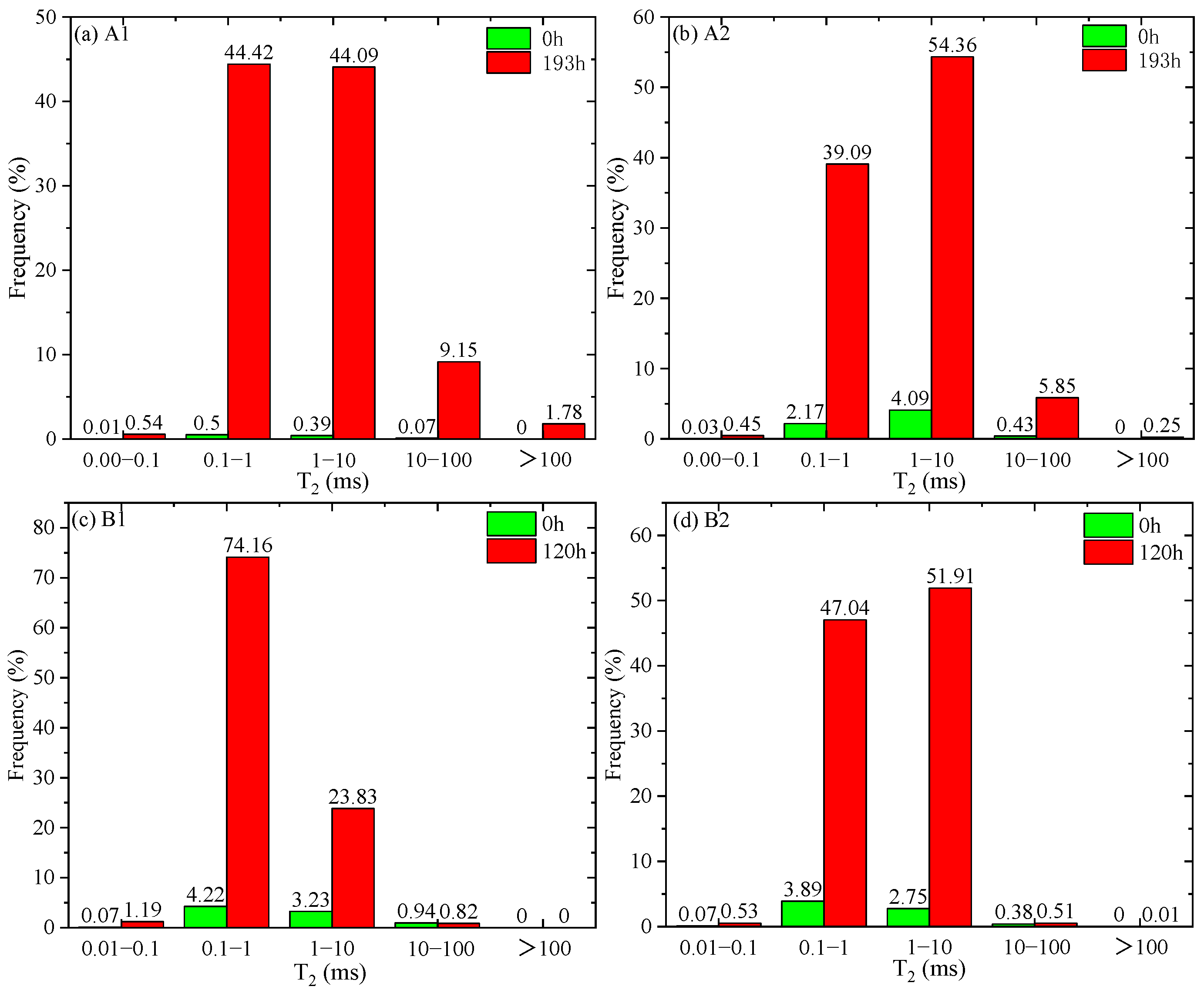
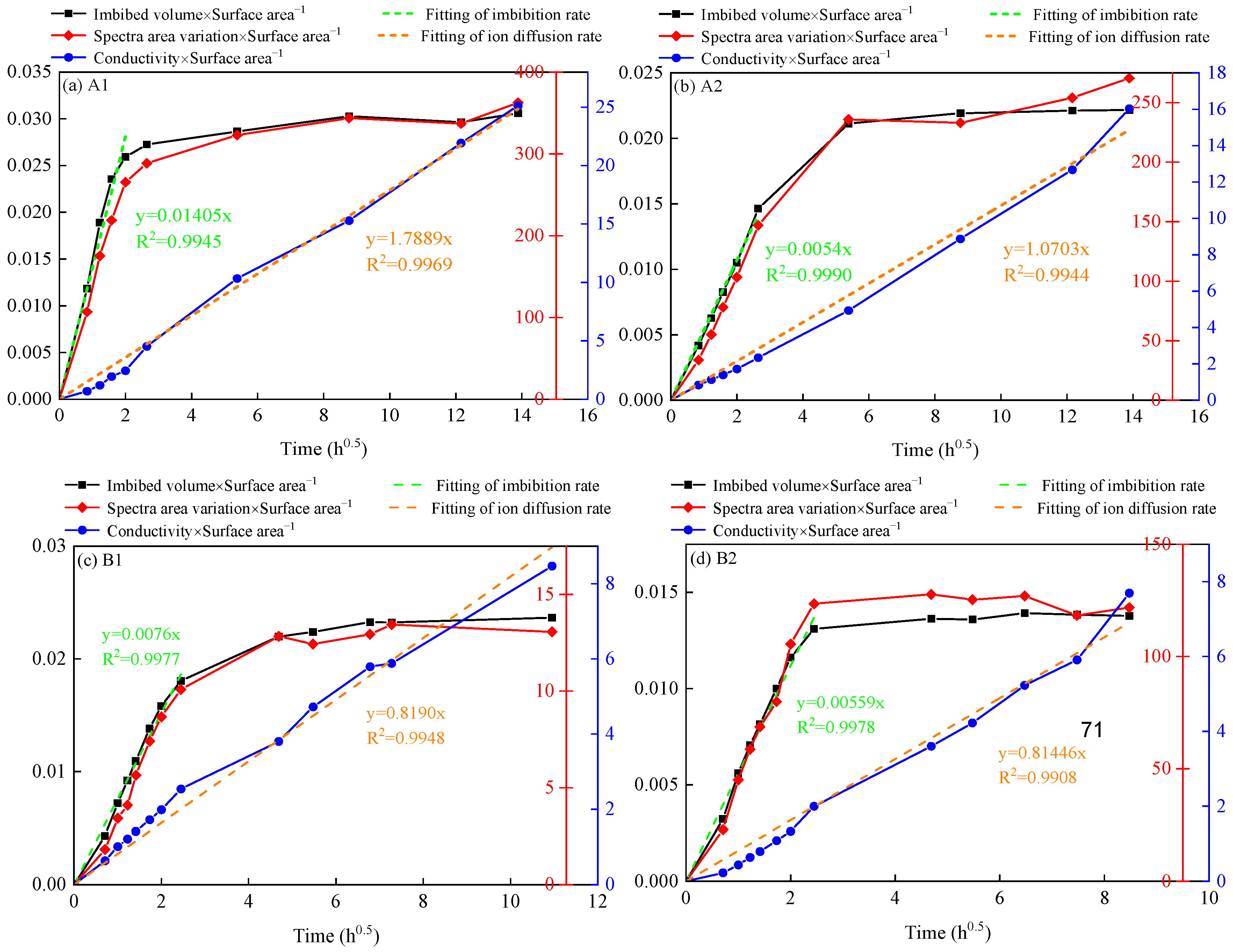

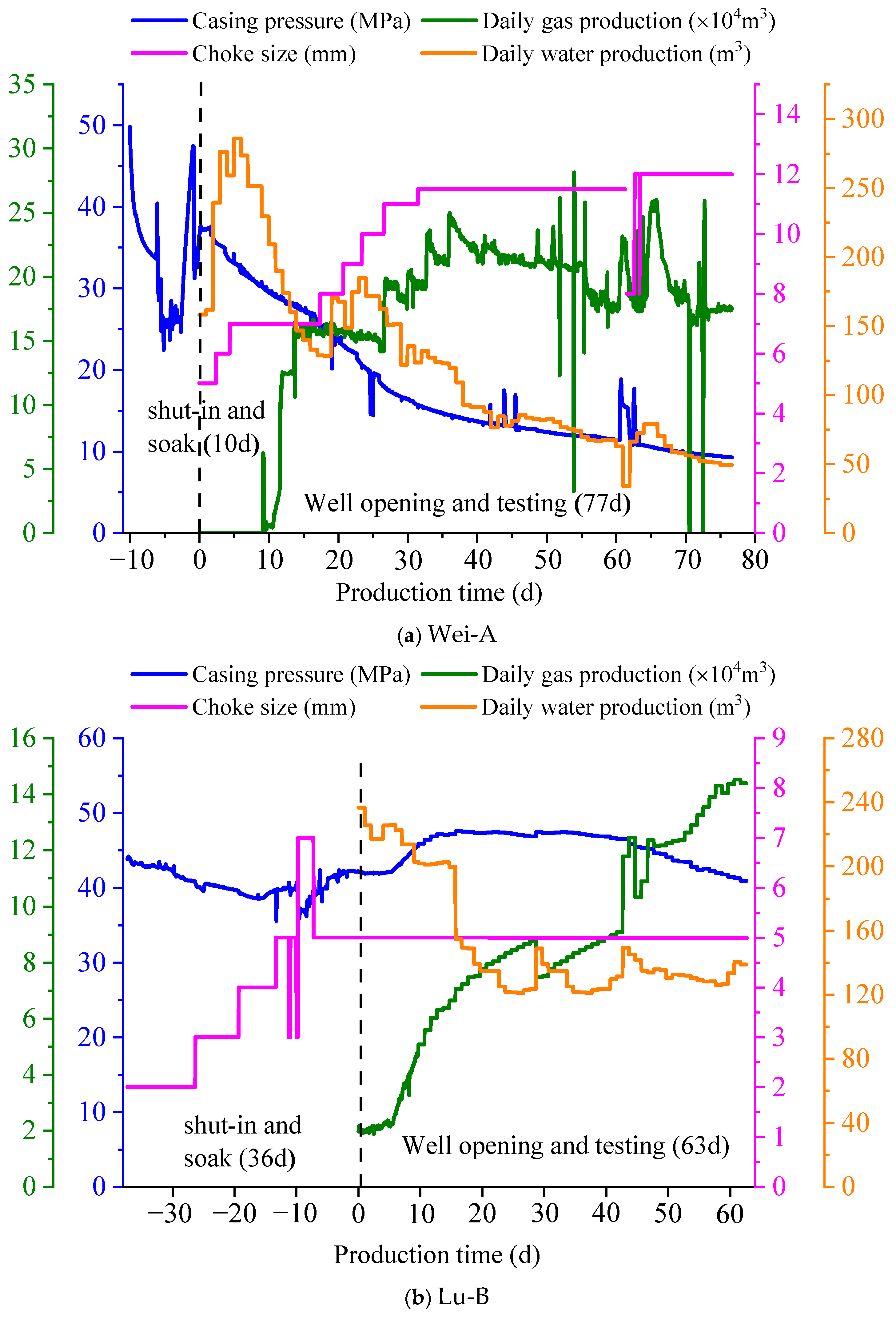
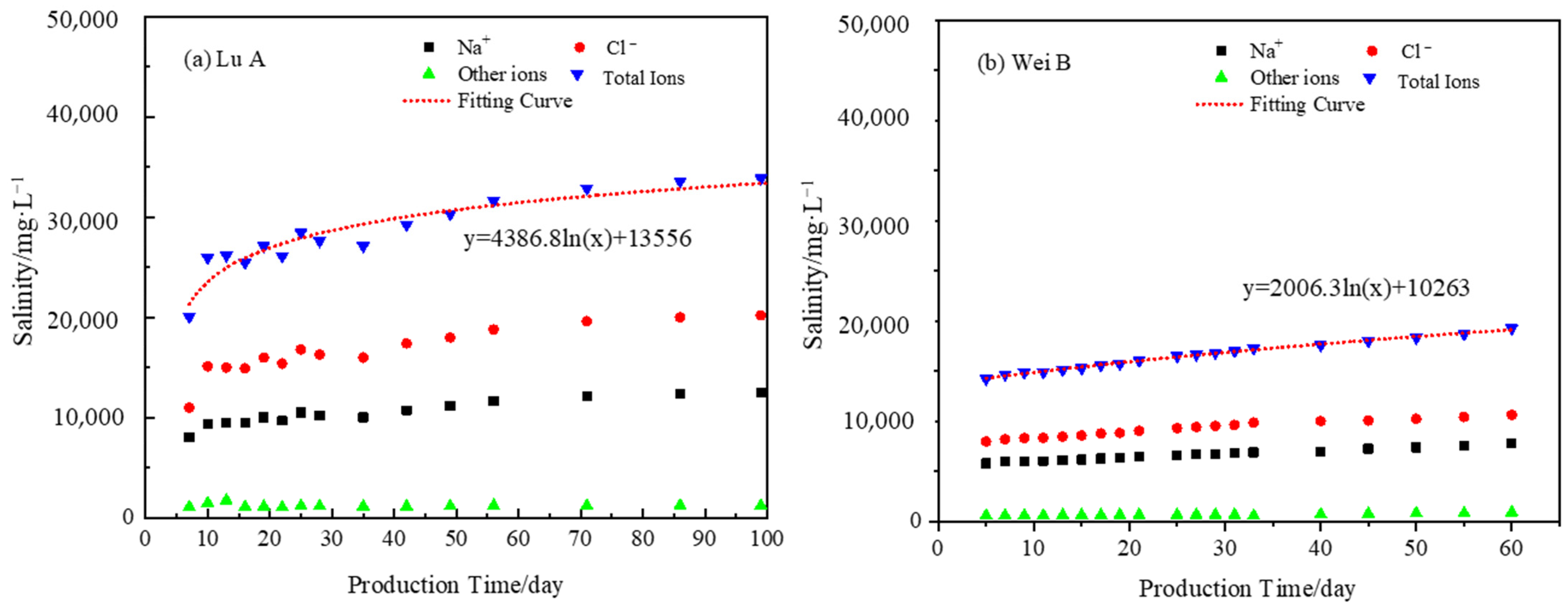



| Sample | Depth/m | Length/cm | Diameter/cm | Mass/g | Porosity/% | Permeability/10−3 μm2 |
|---|---|---|---|---|---|---|
| Lu-A1 | 3986.12 | 23.51 | 25.32 | 28.82 | 6.21 | 0.019 |
| Lu-A2 | 3989.18 | 21.38 | 25.19 | 27.46 | 5.45 | 0.012 |
| Wei-B1 | 2705.18 | 22.46 | 25.00 | 27.03 | 8.41 | 0.120 |
| Wei-B2 | 2710.13 | 23.41 | 25.11 | 29.12 | 7.89 | 0.145 |
Disclaimer/Publisher’s Note: The statements, opinions and data contained in all publications are solely those of the individual author(s) and contributor(s) and not of MDPI and/or the editor(s). MDPI and/or the editor(s) disclaim responsibility for any injury to people or property resulting from any ideas, methods, instructions or products referred to in the content. |
© 2025 by the authors. Licensee MDPI, Basel, Switzerland. This article is an open access article distributed under the terms and conditions of the Creative Commons Attribution (CC BY) license (https://creativecommons.org/licenses/by/4.0/).
Share and Cite
Li, L.; Ye, X.; Lyu, Z.; Zhang, X.; Yu, W.; Huang, T.; Yu, X.; Yu, W. In-Depth Analysis of Shut-In Time Using Post-Fracturing Flowback Fluid Data—Shale of the Longmaxi Formation in the Luzhou Basin and Weiyuan Basin of China as an Example. Processes 2025, 13, 1832. https://doi.org/10.3390/pr13061832
Li L, Ye X, Lyu Z, Zhang X, Yu W, Huang T, Yu X, Yu W. In-Depth Analysis of Shut-In Time Using Post-Fracturing Flowback Fluid Data—Shale of the Longmaxi Formation in the Luzhou Basin and Weiyuan Basin of China as an Example. Processes. 2025; 13(6):1832. https://doi.org/10.3390/pr13061832
Chicago/Turabian StyleLi, Lingdong, Xinqun Ye, Zehao Lyu, Xiaoning Zhang, Wenhua Yu, Tianhao Huang, Xinxin Yu, and Wenhai Yu. 2025. "In-Depth Analysis of Shut-In Time Using Post-Fracturing Flowback Fluid Data—Shale of the Longmaxi Formation in the Luzhou Basin and Weiyuan Basin of China as an Example" Processes 13, no. 6: 1832. https://doi.org/10.3390/pr13061832
APA StyleLi, L., Ye, X., Lyu, Z., Zhang, X., Yu, W., Huang, T., Yu, X., & Yu, W. (2025). In-Depth Analysis of Shut-In Time Using Post-Fracturing Flowback Fluid Data—Shale of the Longmaxi Formation in the Luzhou Basin and Weiyuan Basin of China as an Example. Processes, 13(6), 1832. https://doi.org/10.3390/pr13061832





